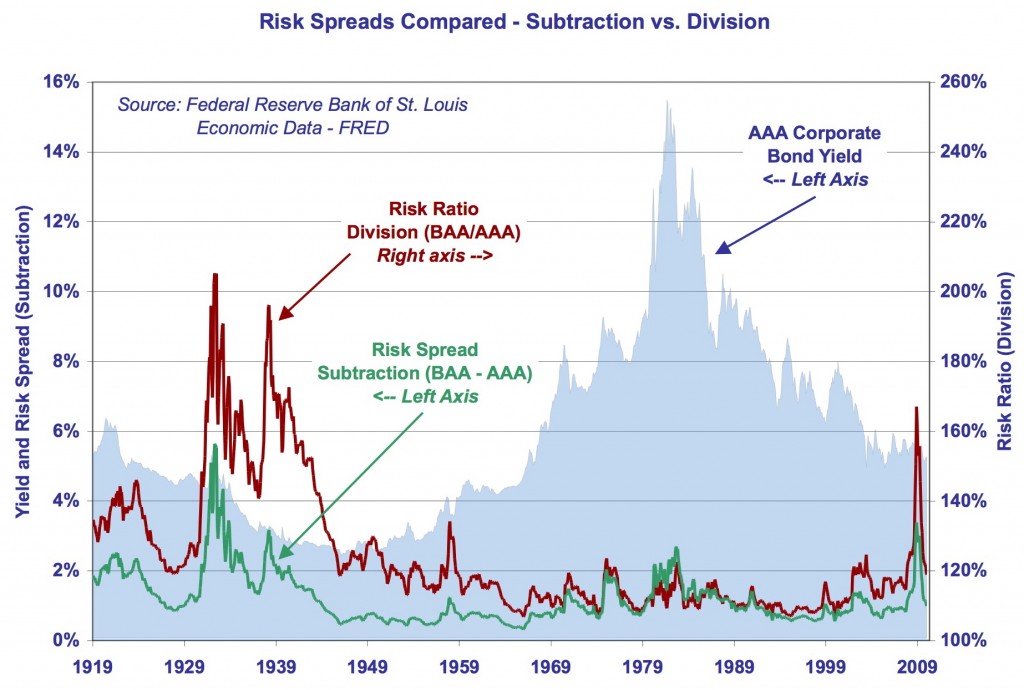Two Measures of Bond Yield Risk – Which Is Better?
 Are investors presently risk averse? Or are they pursuing high risk investments? The answers are important to understanding the tone of markets, particularly when there have been large moves one way or another. For bond investors, “spread” is the magic measure. What I want to address here is two ways spread is measured and the benefits of each.
Are investors presently risk averse? Or are they pursuing high risk investments? The answers are important to understanding the tone of markets, particularly when there have been large moves one way or another. For bond investors, “spread” is the magic measure. What I want to address here is two ways spread is measured and the benefits of each.
Over the past two years, we’ve read a lot about interest rate spreads revealing problems with the financial system. For example, the London InterBank Offered Rate (LIBOR – the rate at which banks lend to one another) vs. US Government rates reached historic highs in late 2008. That spread commonly is measured by simple subtraction: LIBOR minus a government short-term yield equals spread. It’s now basically back to normal, so we see little mention of it anymore.
But there are other fixed-income spreads that are tracked regularly. They measure spreads between securities that have different characteristics. For example, time (longer-term bond yields vs. shorter-term) and credit risk (lower-rated bond yields vs. higher-rated).
What I want to address is the calculations done to measure these spreads. (Wait! Don’t leave yet. I promise these calculations use simple arithmetic.)
There are two basic approaches: subtraction and division. Most often we see the former, although there is some use of division. The decision as to which to use is important because there can be different results over time.
I want to focus on credit risk, namely the AAA bonds (highest rated) vs. BAA bonds (lowest rated of “investment grade” bonds). For an example, let’s assume AAA bonds currently yield 6% and BAA bonds yield 8%. Now compare the two methods:
Subtraction. Subtract the AAA bond yield from the BAA one: 8% minus 6% equals 2%.
Division. Divide the BAA bond yield by the AAA one: 8% divided by 6% equals 1.33 or 133%. (Barron’s has long published its “confidence index” calculated by reversing this division and multiplying by 100. For these numbers, they would calculate a confidence index of 6/8 x 100 = 75.)
Note that spread analysis at one point in time gives us no real information. We need a time series of similar measures over time in order to judge what is normal, how the current time compares and what the trend seems to be.
So, how do the two compare? Here are two graphs that show 90-year history. I have included all data from 1919 because there is still so much comparison being made between today and the Great Depression of 1929-1932. Corporate bond yields and spreads is one of many areas that are very different from today.
First, a look at the bond yields. You can see the many places these rates have visited over the years. And you can get a sense of where risk became a concern – i.e., when BAA bond yields were markedly higher than AAA bonds.
Now, let’s look at the spread measures. Notice that subtraction and division can produce different results, depending on the level of yields. For example, take two sets of yields: 5% – 4% and 8% – 7%. Each pair produces a spread of 1% by subtraction. But, using division, we get ratios of 125% and 114.3%.
Easiest to see on the graph are the years 1932, the bottom of the depression sell-off, and 1939, a subsequent bottom. In both times, the division ratio shows the BAA yield was 200% of the AAA. Yet, the spread had fallen from 5.5% to 3.25% as the yields dropped from about 11% – 5.5% to 6.5% – 3.25%.
So, which measure is better? Personally, I like both. Subtraction gives us the starting point for understanding what we can earn, through compounding, from different risk bonds. Division gives us a better measure of stress. To have BAA bonds selling at twice the AAA yield is indicative of problems, regardless of the level and spread of the rates.







Insightful article! It is interesting how compressed spreads became during the height of bond yields in the early 80s.